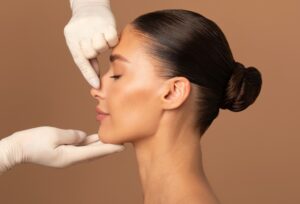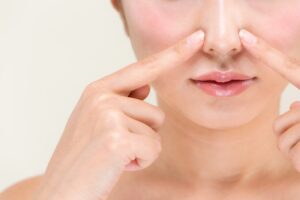Rhinoplasty
Nose surgery, medically known as rhinoplasty, can help improve both the form and function of your nose. If you have experienced self-consciousness or many years of low self-esteem because of the way your nose looks, experienced plastic surgeon Scott Miller, MD can perform this procedure to restore balance among your facial features for results that look natural. Rhinoplasty can also be helpful for patients with breathing problems due to nasal issues, such as a deviated septum. Whether you are considering rhinoplasty for functional or cosmetic reasons, Dr. Miller performs this facial plastic surgery procedure to address your concerns and successfully meet your needs.
“ Dr. Miller went above and beyond with my revision rhinoplasty, taking care to really understand the look I wanted, while also improving my internal nasal physiology for optimal function. This has improved my breathing and quality of life in addition to creating the gorgeous NATURAL look that I wanted.”
Explore Topics On This Page
Benefits of Rhinoplasty
There is no single “perfect” or “designer” nose. Cosmetic nasal surgery simply brings the nose into harmony with the rest of the face. This can be accomplished by reducing the overall size, removing a bump, narrowing or widening the sides of the nose, or improving the details of the nasal tip and the angle between the nose and upper lip. Unbalanced, crooked, or curved noses can be straightened and made more symmetrical. From a functional standpoint, breathing can be improved and a deviated septum can be corrected.
Simply put, the nostrils, nasal tip, bridge, or septum can be altered to achieve your desired look. The procedure can be performed to improve:
- The overall dimensions of the nose
- A crooked or misaligned nasal bridge
- A noticeable bump on the nasal bridge
- Nostrils that appear too thin or wide
- A bulbous or drooping nasal tip
- A deviated septum or impaired breathing through the nasal passages
Dr. Miller personalizes nose surgery to enhance facial harmony while preserving the character of your face for results that appear natural. With consideration of the concerns you would like to correct, he uses advanced nose contouring techniques to achieve your cosmetic goals.
Who is a Candidate for Rhinoplasty?
Rhinoplasty can benefit patients who would like to improve the appearance or function of their nose and achieve a long-lasting outcome. If you are considering cosmetic nose surgery, you should:
- Have realistic expectations about what rhinoplasty can achieve
- Be healthy enough to withstand recovery
- Not have any uncontrolled medical conditions
- Not smoke at least six weeks before and after surgery
Dr. Miller will meet with you for an initial consultation to discuss your needs and goals. During this meeting, he will explain all aspects of the rhinoplasty procedure, including the potential risks and benefits of treatment. Dr. Miller encourages you to ask any questions you may have and he will be happy to address all of your concerns. Our team will also review your medical history to help ensure you are a good candidate for the procedure.
How is the Rhinoplasty Procedure Performed?
Working from either entirely inside the nose, or through small incisions made on the undersurface of the nose just before it meets the upper lip, Dr. Miller will carefully modify and reshape nasal bones and cartilage to create the desired results. Incisions made on the outside of the nose are strategically placed so that any residual scarring should be virtually undetectable.
Rhinoplasty usually takes between one to three hours to complete. After surgery, a cast is temporarily placed to maintain the new shape and protect the nose. Splints may also be inserted inside the nose for extra support. Rhinoplasty can typically be performed on an outpatient basis.
Open vs. Closed Rhinoplasty
Open and closed rhinoplasty refer to the incisions used to access the bones and cartilage of the nose. During open rhinoplasty, an incision is made along the natural crease of the columella (the strip of tissue between the nostrils). This can provide a clear view of the nasal framework so Dr. Miller can alter the skin, bones, and cartilage according to your goals. Closed rhinoplasty, on the other hand, involves an incision made on the inside of the nose, resulting in no external scarring whatsoever. This technique is sometimes called an “endonasal” approach. Most procedures in which a deviated septum is corrected can be performed using the closed incision.
What is Recovery From Rhinoplasty Like?
Patients are usually up and around in a day or two following the rhinoplasty procedure. Head elevation and placing cold compresses on the eyes for a brief period after surgery can minimize swelling and bruising. Any lasting discomfort can be controlled with medication. The splints and cast are typically removed within a week. Most bruising fades within 7 to 10 days, allowing an inconspicuous return to work and other daily activities. There will be subtle swelling of the nose, which recedes slowly over time. It’s important to be extra cautious about protecting the nose from harm during the recovery period. The full benefits of rhinoplasty should become evident over the next several weeks and months.
How Long Does Rhinoplasty Last?
The final result from rhinoplasty can be a permanent improvement that lasts a lifetime! Most swelling should subside within the first few months, although it can take up to a year for the nose to fully heal. As the outcome continues to reveal itself, Dr. Miller recommends taking care to protect the nose when playing sports or engaging in recreational activities that may lead to facial impact.
How Much Does Rhinoplasty Cost?
Rhinoplasty is designed to create balance among the facial features for a proportionate result. As the central characteristic of the face, refining the nasal dimensions can typically bring your other features—such as your cheeks, eyes, and lips—into greater harmony for an enhanced aesthetic overall. The techniques used to perform rhinoplasty vary from patient to patient, and the price of rhinoplasty will be unique to each individual as well. Rhinoplasty fees usually range from $9,000 to $15,000. Common factors that usually affect the cost of nose surgery include:
- The location where the incision is made
- The details of your treatment plan and the surgical techniques used
Once Dr. Miller sees you in a consultation, our Patient Care Coordinator will present you with a personalized quote and full price breakdown. We appreciate the need to bring the cost of rhinoplasty into your budget, which is why we work with CareCredit®. This plastic surgery financing option offers qualified applicants a number of payment plans with low monthly installments to suit your unique budget. Please reach out to our team for more information on our accepted modes of payment.
Is Non-Surgical Rhinoplasty Possible?
In some cases, minimally invasive dermal fillers such as Restylane® or JUVÉDERM® can be used to smooth bumps in the nasal bridge and recontour the nose for temporary enhancement. This is often referred to as a “liquid rhinoplasty.” However, the aesthetic goals that can be achieved with this technique are limited in scope and the outcome will eventually require retreatment. Since rhinoplasty allows your plastic surgeon to permanently refine the bones and cartilage of the nasal framework, there is currently no non-surgical treatment that can mirror the quality of results achieved by nose surgery.
Are There Any Rhinoplasty Alternatives?
Nose surgery is generally the only way to repair or recontour the nose for long-term results. However, facial implants for the chin can potentially improve the appearance of your nose by balancing the proportions of your face, often making the nose appear smaller and more proportional. This can be beneficial for patients who have a recessed chin or who lack defined contours in the lower face. If you are interested in a chin implant, Dr. Miller can evaluate your features and recommend the best treatment plan to achieve your goals.
“Dr. Miller is amazing! I am so happy with my results. During the consultation I felt that he had all the time in the world to answer my questions and explain all the options that were available. The entire staff is so kind and professional.”
Choosing the Best Rhinoplasty Surgeon for You
While you are in the process of selecting a skilled plastic surgeon to perform your rhinoplasty, there are many factors that you should consider to ensure you are in the hands of a surgeon who is well-qualified to achieve your desired results. These considerations may include:
- Experience: It is usually true that the more experience a plastic surgeon has performing rhinoplasty, the greater the likelihood that they will be able to achieve an exceptional result. Research your prospective surgeon’s training, educational background, and whether they are board-certified by the American Board of Plastic Surgery to gain an idea of his or her practice experience. Board-certification by the ABPS demonstrates an advanced level of training and competency in all plastic surgery procedures.
- Quality of Care: Your rhinoplasty should take place in a well-equipped surgical facility under the highest standards of safety, cleanliness, and professionalism. Try to learn where your prospective surgeon will perform the procedure and make sure they operate in a hospital or accredited surgical center.
- Reputation: While your results will be the ultimate measure of your satisfaction after treatment, it’s important to select a rhinoplasty surgeon who is capable of making your experience comfortable, educational, pleasant, and professional from start to finish. Read online reviews from platforms like Facebook, Google, Yelp, and Realself to learn about the type of care you can expect from a practice, and use these assessments to gauge the satisfaction of previous patients after their procedure.
- Aesthetic Expertise: Explore a plastic surgeon’s photo gallery to see examples of their work and the previous outcomes achieved with rhinoplasty. As the nose is an integral component of your overall facial harmony, it is essential that the results showcased in your prospective surgeon’s portfolio mirror your aesthetic desires.
- Communication: Once you have scheduled a consultation with an experienced plastic surgeon, you will have the opportunity to meet them and ask any questions you may have about their training or the overall rhinoplasty procedure. Make sure he or she thoroughly informs you about the entire process and answers all of your questions with patience and compassion. Remember, your surgeon should never make you feel pressured, rushed, or uneasy about making a decision.
While deciding who to entrust with your safety and appearance may seem like a daunting task, keeping these factors in mind throughout the research process can help you find the best rhinoplasty surgeon for your needs and goals. If you have any questions, please reach out to Miller Cosmetic Surgery for more information.
Frequently Asked Questions About Rhinoplasty
Will I have a scar after rhinoplasty?
Visible scarring should be virtually undetectable after surgery, as Dr. Miller places the incision either internally or within the crease of the columella (the strip of tissue between the nostrils).
How can I reduce swelling after rhinoplasty?
It’s normal for swelling around the nose to persist for a few months after surgery, but using nasal tape and applying cold compresses around the cheeks can help manage swelling until it subsides completely. Furthermore, keeping the head elevated above the heart while sleeping can minimize inflammation by promoting blood flow. After your procedure, Dr. Miller and his team will give you additional instructions on how to reduce post-operative swelling.
When can I blow my nose after rhinoplasty?
You should avoid blowing your nose for two to four weeks after rhinoplasty, although this timeframe may vary according to which parts of the nasal structure were operated on during your surgery. While it’s normal to feel stuffed up following rhinoplasty, blowing your nose with excess force may cause bleeding. Dr. Miller will advise you on the best way to manage congestion in the first few weeks after rhinoplasty.
How long until I can wear glasses after rhinoplasty?
It’s best to avoid putting any type of excess pressure on the nose while it heals, so you should avoid wearing glasses and sunglasses for at least four weeks after your surgery.
How do I clean my nose after rhinoplasty?
To clean the inside of your nose without damaging the healing tissue, you can gently remove dried mucus and blood from the nostrils using hydrogen peroxide, an over-the-counter solution, and a Q-tip. You can also apply a rinse of saline solution through a bulb—making sure to keep the tip of the bulb at the base of the nose—to irrigate the nostrils and prevent dryness in the nasal lining.
Does male rhinoplasty differ from female rhinoplasty?
The general techniques used in open and closed rhinoplasty are the same for all patients, but male facial plastic surgery procedures are performed with unique consideration of the masculine contours of the face. Men and women typically have distinctive differences in the width, size, and dominance of their nose and Dr. Miller will always perform rhinoplasty to preserve the natural character of a patient’s features. He is especially mindful of achieving results that enhance without looking “overdone” or artificial.
How long does it take to heal from rhinoplasty?
The majority of healing after rhinoplasty typically occurs within the first two weeks of your recovery. After one month, there should be little to no swelling or bruising and the nose should continue to refine over the following months. At the point of three to six months into your recovery, healing is considered virtually complete—the outcome will continue to mature and improve up to one year post-operatively. The exact timeline of your healing process generally varies according to which improvements were made.
What is the difference between septoplasty and rhinoplasty?
Septoplasty is performed to straighten a crooked or misaligned septum with the goal of improving breathing. This is accomplished by removing/restructuring bone and cartilage that may be limiting airflow. Rhinoplasty, on the other hand, is generally pursued to refine cosmetic issues that are impacting facial balance. Both procedures aim to improve the nose, but the goals of septoplasty are more functional in nature when compared to rhinoplasty. That said, the two procedures can be performed at the same time to resolve both cosmetic and physiological concerns if necessary.
Should I get rhinoplasty or facial implants?
Both rhinoplasty and facial implants share the common goal of improving facial balance, so some patients may question which cosmetic surgery is the most ideal treatment option for their needs. If you are satisfied with the projection of your chin but feel you would benefit from a more proportional nose, rhinoplasty is likely the most beneficial solution. However, a customized chin implant can also be very effective at enhancing facial harmony while simultaneously offsetting an overly dominant nose. A personal consultation is the only way to truly determine the best procedure for your goals and the types of improvement you seek.
What are the risks of rhinoplasty?
Every procedure comes with a risk of potential complication, which is often exacerbated when patients are not under the care of a qualified surgeon. Rhinoplasty is no exception. Nose surgery and all surgical procedures involve the possibility of negative reactions to the anesthesia, infection, or bleeding. With rhinoplasty, unique risks include nasal contour irregularities, discoloration, septal perforation, numbness, and difficulty breathing. Selecting a board-certified and fellowship-trained aesthetic surgeon is key to maximizing your safety, as these events are extremely rare when the procedure is performed by an experienced plastic surgeon.
Please contact Dr. Scott Miller for more information on rhinoplasty, or to schedule a consultation. We look forward to answering any questions you may have.









